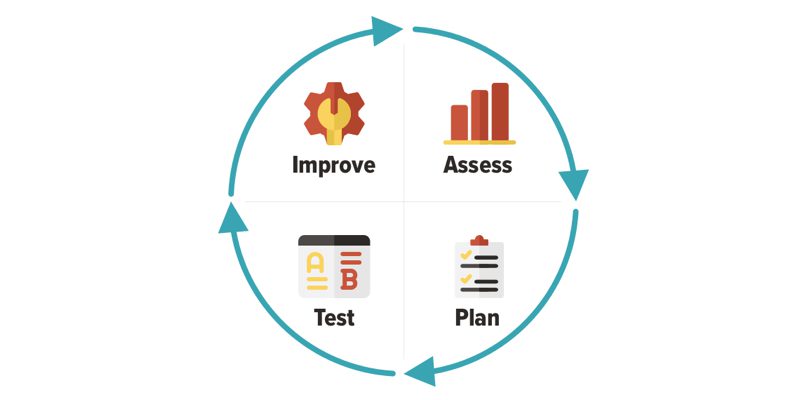Website optimization is crucial for improving your site’s performance and user experience. It can boost your traffic and increase conversions.
A well-optimized website loads faster, ranks higher on search engines, and keeps visitors engaged. But what exactly does website optimization entail? It includes various techniques like improving page speed, enhancing SEO, and ensuring mobile-friendliness. This process can seem overwhelming, but it’s essential for your online success.
By understanding the basics of website optimization, you can make informed decisions that benefit your site. In this post, we’ll explore the key aspects of website optimization, giving you practical tips and insights. Ready to transform your website into a user-friendly, high-performing platform? Let’s dive in.
Table of Contents
ToggleIntroduction To Website Optimization
Website optimization is the process of using advanced strategies to improve your website’s performance. This includes various methods like enhancing page speed, ensuring a smooth user experience, and making content more accessible. Optimized websites attract more visitors, keep them engaged longer, and encourage them to take action. In this section, we will explore the importance of speed and the impact on user experience.
Importance Of Speed
Website speed is crucial for user retention. A fast-loading site makes users happy. They don’t have to wait long. This leads to lower bounce rates. Search engines like Google also prefer fast websites. They rank higher in search results. This increases visibility. More visitors can find your site easily. Here are some key points:
- Improved User Retention: Fast sites keep users engaged.
- Higher Search Engine Ranking: Google favors speedy websites.
- Increased Conversions: Users are more likely to take action.
Speed can make or break your website’s success. Investing in speed optimization is essential.
User Experience Impact
User experience (UX) is how users feel when they use your site. Good UX makes visitors happy. They find what they need quickly. This includes easy navigation, clear content, and responsive design. Here are some elements that impact UX:
| Element | Impact on UX |
|---|---|
| Navigation | Easy to find information |
| Content Clarity | Understandable and relevant content |
| Responsive Design | Works well on all devices |
Good UX keeps users on your site longer. They are more likely to return. They may even recommend your site to others. Focusing on UX is crucial for website optimization.

Credit: innovativeadagency.com
Analyzing Current Performance
Understanding your website’s current performance is essential for optimization. Before making changes, it is critical to analyze its present state. This helps in identifying areas that need improvement. Two key steps in this process are using speed tests and identifying bottlenecks.
Using Speed Tests
Speed tests are vital for checking your website’s load time. A fast website ensures a better user experience. Use tools like Google PageSpeed Insights or GTmetrix to measure speed. These tools provide a detailed report on various performance metrics.
Here are some steps to follow:
- Enter your website URL in the speed test tool.
- Analyze the results provided by the tool.
- Focus on the load time and other critical metrics.
Speed test tools often highlight key areas for improvement. Pay attention to metrics such as:
- First Contentful Paint (FCP): Time taken to render the first bit of content.
- Largest Contentful Paint (LCP): Time taken to render the largest content element.
- Cumulative Layout Shift (CLS): Measures visual stability of the page.
Identifying Bottlenecks
Identifying bottlenecks helps in improving your website’s performance. Bottlenecks are areas slowing down your site. Common bottlenecks include large images, slow server response times, and excessive JavaScript.
Here’s a simple way to identify bottlenecks:
- Use the speed test results to pinpoint slow areas.
- Check the size and load time of images.
- Analyze server response times.
- Look for excessive or blocking JavaScript.
Use the following tips to address common bottlenecks:
- Optimize images by compressing and resizing them.
- Use a Content Delivery Network (CDN) to improve server response times.
- Minify and defer JavaScript to reduce load times.
Addressing bottlenecks can significantly boost your website’s performance. Regularly monitor and optimize your site to keep it running smoothly.
Improving Load Times
Improving load times is crucial for website optimization. Faster load times lead to better user experience and higher search engine rankings. Let’s explore some effective methods to improve your website’s load times.
Optimizing Images
Images often contribute to slow load times. Optimizing them can significantly enhance performance. Use the following tips:
- Compress images without losing quality. Tools like TinyPNG can help.
- Choose the right file format. JPEG for photos, PNG for graphics.
- Resize images to the exact dimensions needed on the website.
- Use
srcsetfor responsive images. It ensures the correct image size loads for different devices.
Minifying Css And Javascript
Minifying CSS and JavaScript files reduces their size. This leads to faster load times. Follow these steps:
- Remove unnecessary characters like spaces, commas, and comments from code.
- Use tools like CSSNano for CSS and UglifyJS for JavaScript.
- Combine multiple CSS and JavaScript files into one. This reduces the number of HTTP requests.
- Use asynchronous loading for JavaScript. It ensures scripts load without blocking the page render.
By implementing these strategies, you can improve your website’s load times. This will provide a better experience for your users and improve your SEO rankings.

Credit: blog.hubspot.com
Enhancing Server Response
Enhancing server response is a critical aspect of website optimization. A faster server response can improve user experience and boost search engine rankings. This section will explore two key strategies: leveraging caching and upgrading hosting.
Leveraging Caching
Caching stores copies of files to reduce load times. It speeds up server responses by serving cached content to users. There are different types of caching:
- Browser Caching: Stores website resources on the user’s device.
- Server-Side Caching: Stores web pages and database queries on the server.
- Content Delivery Network (CDN) Caching: Uses a network of servers to deliver content faster.
Implementing caching can significantly reduce server load. It improves the speed at which your website loads. Use caching plugins for WordPress like W3 Total Cache or WP Super Cache. These plugins are easy to set up and effective.
Upgrading Hosting
Hosting quality directly affects server response time. Consider upgrading your hosting plan if you experience slow server responses. Different types of hosting include:
| Hosting Type | Description |
|---|---|
| Shared Hosting | Multiple websites share the same server resources. It is cost-effective but can be slow. |
| VPS Hosting | Virtual Private Server offers dedicated resources. It is faster and more reliable than shared hosting. |
| Dedicated Hosting | Entire server resources dedicated to your website. It provides the best performance but is expensive. |
| Cloud Hosting | Uses multiple servers to host your website. It is scalable and reliable. |
For better performance, choose VPS or dedicated hosting. These plans offer more resources and faster server responses. Cloud hosting is also a good option, providing scalability and reliability.
Mobile Optimization
Mobile optimization is essential in today’s digital world. More users access websites via mobile devices than desktops. Ensuring a seamless mobile experience can boost engagement and conversion rates.
Responsive Design
A responsive design adapts your website to any device. Whether a user is on a phone, tablet, or desktop, the site should look and function well. This improves user experience and search engine ranking.
Key elements of responsive design:
- Flexible layouts
- Fluid images
- Media queries
By using CSS media queries, you can adjust the design based on the screen size. This ensures that text, images, and navigation are user-friendly on all devices.
Accelerated Mobile Pages
Accelerated Mobile Pages (AMP) is a Google-backed project. It aims to speed up content delivery on mobile devices. AMP pages load faster by using a simplified HTML and limited JavaScript.
Benefits of implementing AMP:
- Faster load times
- Improved mobile search ranking
- Enhanced user experience
To create an AMP page, use the amp-html format. This involves:
- Using
amp-imgfor images - Including
amp-videofor videos - Adding
amp-adfor ads
AMP pages are cached by Google, ensuring quick delivery to users. This can significantly reduce bounce rates and improve engagement.
Seo Best Practices
Website optimization is crucial for ensuring your site ranks well in search engines. Following SEO best practices can help improve your site’s visibility and attract more visitors. Let’s explore some essential strategies.
Improving Site Structure
A well-organized site structure makes it easy for search engines to crawl and index your content. Here are some tips:
- Use a clear hierarchy: Organize your content with categories and subcategories.
- Internal linking: Link related pages within your site to enhance navigation.
- Breadcrumbs: Implement breadcrumbs to help users and search engines understand your site’s structure.
For example, a clothing store might structure its site like this:
| Main Category | Subcategory | Example Page |
|---|---|---|
| Men | Shirts | Formal Shirts |
| Women | Dresses | Evening Gowns |
Keyword Optimization
Keywords help search engines understand your content. Optimize them effectively:
- Research keywords: Use tools like Google Keyword Planner to find relevant keywords.
- Use primary keywords: Include your main keyword in the title, headers, and first paragraph.
- Long-tail keywords: Incorporate specific phrases that users might search for.
Here’s an example of keyword usage:
Title: Best Formal Shirts for Men in 2023
By following these strategies, you ensure your website is optimized for search engines. This can lead to higher rankings and more traffic. You should also regularly update your website with fresh and relevant content, as this can help improve your search engine rankings. Additionally, paying attention to your website’s loading speed and mobile-friendliness can further increase your website traffic. By focusing on these key areas, you can maximize the potential of your website and attract more visitors. In addition, utilizing social media and online advertising can also be effective strategies to increase website traffic. By promoting your website and engaging with your audience on various social media platforms, you can drive more visitors to your site. Furthermore, running targeted online advertising campaigns can help you reach and attract potential customers who may not have found your website through organic search. Overall, implementing these strategies to increase website traffic can greatly benefit your online presence and ultimately help your business thrive.
Monitoring And Maintenance
Maintaining a website is not a one-time task. Consistent monitoring and maintenance are crucial for optimal performance. Regular check-ups ensure your site stays functional and efficient. Staying updated with the latest trends and technologies keeps your site competitive. Let’s explore these key aspects.
Regular Audits
Regular audits are essential for a healthy website. They help identify areas that need improvement. Here are some key elements to focus on:
- SEO Performance: Check keyword rankings and meta tags.
- Loading Speed: Ensure your site loads quickly.
- Security: Scan for vulnerabilities.
- Content Quality: Update and refresh old content.
Use tools like Google Analytics and Search Console for comprehensive audits. These tools provide valuable insights. They help you understand user behavior and site performance. Consistent audits lead to a better user experience. Additionally, utilizing SEO audit tools can help identify potential technical issues that may be affecting your site’s visibility in search results. These tools can also highlight opportunities for improvement, such as keyword optimization and backlink opportunities. By regularly utilizing these tools, you can ensure that your website is continuously optimized for both users and search engines. Regular use of SEO audit tools is essential for staying on top of any technical issues that may arise. These tools can also help identify areas for improvement, such as optimizing meta tags and improving site speed. By staying proactive with the use of SEO audit tools, you can ensure that your website remains competitive in search engine rankings and provides a seamless user experience.
Staying Updated
The web is always changing. New technologies and trends emerge regularly. Keeping your website updated is vital for staying relevant. Here are some steps to stay updated:
- Follow Industry Blogs: Read blogs like Moz and Search Engine Land.
- Attend Webinars: Participate in online webinars and workshops.
- Join Communities: Be part of forums and groups like Reddit and Stack Overflow.
- Update Software: Ensure your CMS and plugins are up-to-date.
Staying updated helps you implement the latest features. It improves user experience and boosts your site’s performance. Remember, an updated website is a secure website.

Credit: www.orbitmedia.com
Tools And Resources
Optimizing your website is crucial for improving performance and user experience. Several tools and resources can help streamline this process. This section will cover some valuable plugins and online optimization tools to enhance your website’s efficiency.
Useful Plugins
Plugins can significantly improve your website’s functionality. Below are some popular plugins that can help optimize your site:
- Yoast SEO: A comprehensive SEO plugin that helps you optimize your content for search engines.
- W3 Total Cache: Enhances site speed by caching pages and reducing load time.
- Smush: Compresses and optimizes images without losing quality.
- Broken Link Checker: Scans your website for broken links and helps fix them.
- WP Super Minify: Combines, minifies, and caches HTML, CSS, and JavaScript files.
Online Optimization Tools
Online tools provide various features to analyze and improve your website. Here are some essential tools:
| Tool | Description |
|---|---|
| Google PageSpeed Insights | Analyzes page speed and provides suggestions for improvement. |
| GTmetrix | Offers detailed reports on page performance and recommendations. |
| Pingdom | Monitors website uptime and performance, offering detailed insights. |
| Screaming Frog SEO Spider | Crawls websites to identify SEO issues and opportunities. |
| Ahrefs | Provides comprehensive SEO analysis, including backlink tracking and keyword research. |
Using these tools and plugins can greatly enhance your website’s performance. Implementing these resources will result in a more efficient and user-friendly site.
Case Studies
Case studies offer valuable insights into website optimization. They provide real-world examples of what works. By examining successful optimizations and understanding lessons learned, you can improve your site.
Successful Optimizations
Below are some notable examples of successful website optimizations:
| Website | Optimization Strategy | Outcome |
|---|---|---|
| ExampleSite1 | Improved Page Speed | 25% Increase in Traffic |
| ExampleSite2 | SEO Content Update | 30% Higher Conversion Rate |
| ExampleSite3 | Mobile Optimization | 20% Lower Bounce Rate |
These examples show the power of different optimization strategies. They highlight the importance of focusing on specific areas for improvement.
Lessons Learned
Here are some key lessons learned from the case studies:
- Page Speed Matters: Slow pages drive users away. Fast pages keep them engaged.
- Content is King: Updating content with relevant keywords boosts SEO.
- Mobile Optimization is Crucial: A mobile-friendly site attracts more users.
By learning from these examples, you can apply similar strategies. Focus on improving page speed, updating content, and optimizing for mobile. These steps will enhance your website performance and user experience.
What are the benefits of using SEO audit tools to optimize a website’s performance?
Using SEO audit tools can help boost website performance today by identifying technical issues, improving site speed, and optimizing content for search engines. These tools provide valuable insights into website health, keyword ranking, and competitor analysis, ultimately leading to higher visibility and increased organic traffic.
How Can Website Optimization Improve Keyword Difficulty and SEO Strategy?
By implementing website optimization techniques, you can significantly reduce the keyword difficulty of “mastering seo strategy” and enhance your overall SEO strategy. Optimizing website content, improving site speed, and catering to mobile users can all positively impact keyword rankings and make it easier to master SEO strategy.
Frequently Asked Questions
What Is Website Optimization?
Website optimization is the process of improving a site’s performance. This includes faster load times, better user experience, and higher search engine rankings.
Why Is Website Speed Important?
Website speed is crucial for user experience and SEO. Fast-loading sites reduce bounce rates and improve user satisfaction. Search engines also rank faster websites higher.
How To Improve Website Load Time?
To improve load time, optimize images, use a content delivery network (CDN), and minimize code. These steps reduce loading time and enhance user experience.
What Is Mobile Optimization?
Mobile optimization ensures your website performs well on mobile devices. It includes responsive design, fast loading times, and easy navigation.
Conclusion
Optimizing your website is crucial for better performance and user experience. Focus on loading speed and mobile friendliness. Use quality content to engage visitors. Regular updates keep your site relevant. Don’t forget SEO best practices. This helps improve search engine ranking.
Monitor analytics to track progress. Stay ahead of competitors with constant improvements. Your website’s success depends on these optimizations. Start today for noticeable results.








